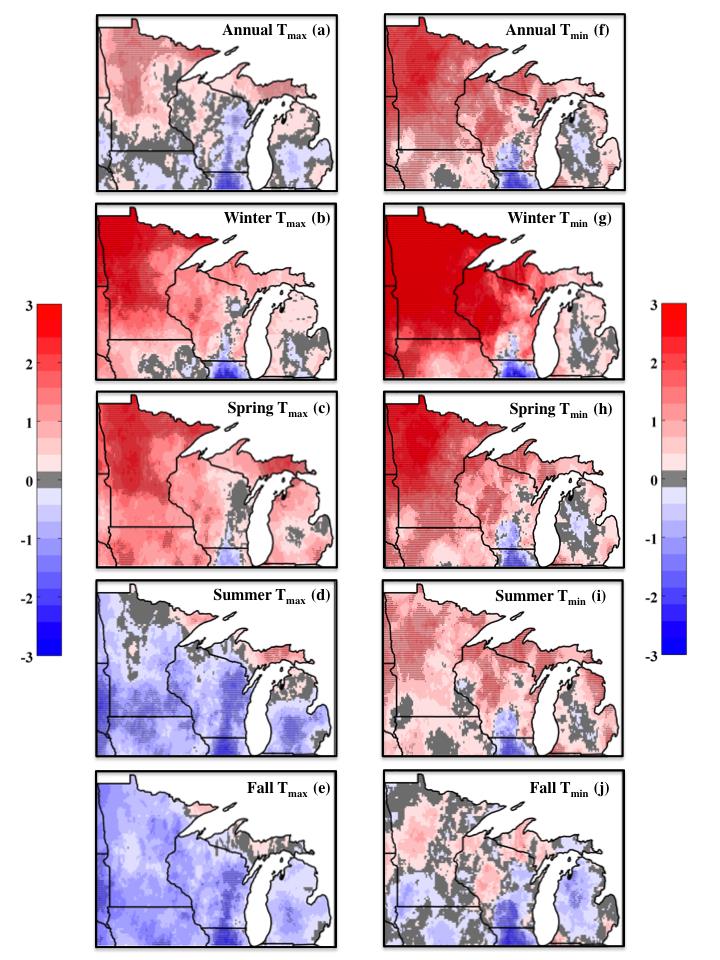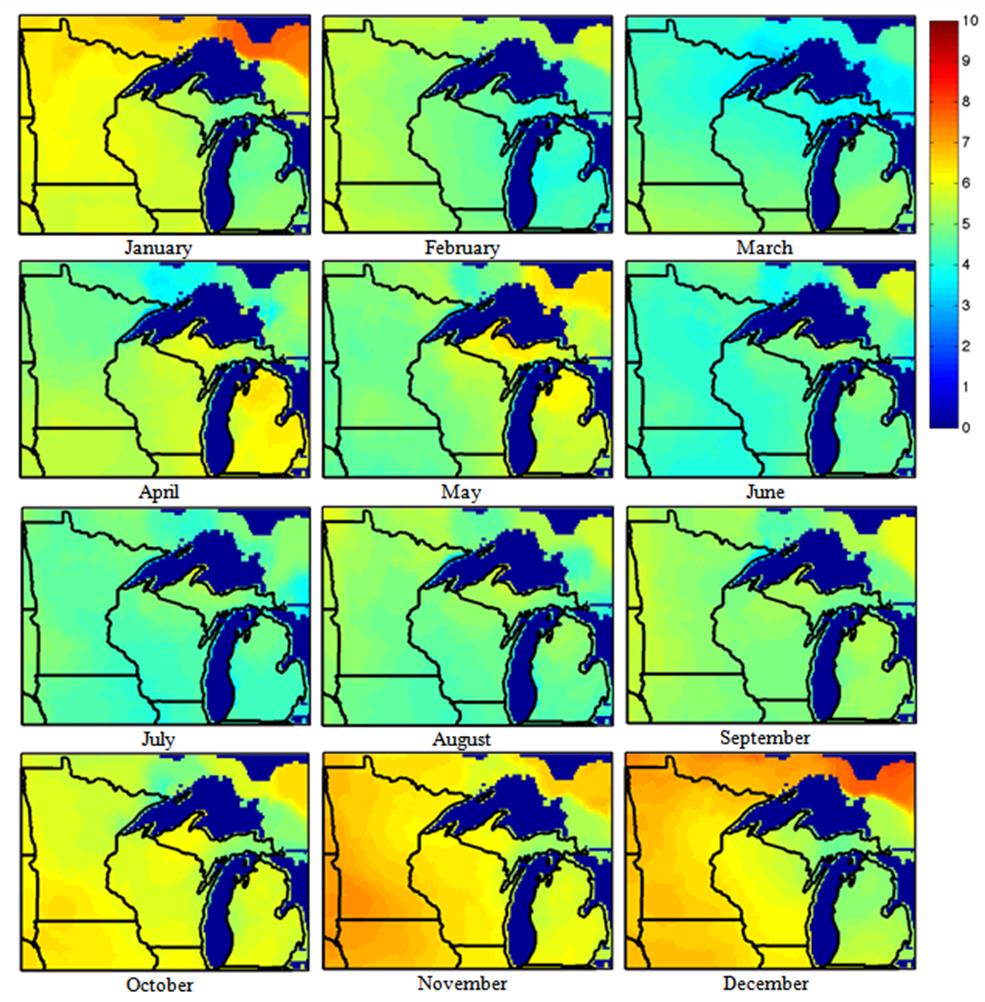Climate Change in Michigan's Upper Peninsula
Observed Climate Changes

An analysis of historic climate data from 1948 to 2007 reveals that the climate of the Midwestern U.S. changed over the past 60 years. During this period, the annual average temperature increased across the Upper Peninsula by as much as 2 degrees C (Motew and Kucharik 2013). Observed changes in temperature were varied seasonally and spatially as illustrated in the figure to the right from Motew and Kucharik (2013). Across the peninsula, winter (December-February) and spring (March-May) maximum and minimum temperatures increased by 0.5 to 3 degrees C, with the most pronounced warming in winter minimum temperature. Changes in summer (June-August) and fall (September-November) temperatures were more seasonally and spatially heterogeneous, with changes ranging from -0.5 to 1 degrees C.
Changes in precipitation patterns have also been observed from 1948 to 2007. In the Upper Peninsula, average annual rainfall increased by as much as 88 mm (Motew and Kucharik 2013), and the frequency and intensity of extreme precipitation events increased across the Midwest (Andresen et al. 2012; Swanston et al. 2011). Like temperature, changes in precipitation patterns were seasonally and spatially heterogenous. Precipitation increased in winter and fall (Motew and Kucharik 2013), corresponding to an increase in snowfall (Andresen et al. 2012). However, the majority of the Upper Peninsula experienced a drier summer, with some areas receiving up to 88 mm less rainfall during summer. In summary, the Upper Peninsula has become both warmer and wetter over the past 60 years with a pronounced decrease in summer precipitation in most of the region. As a result of these climatic changes, the length of the growing season has increased (Andresen et al. 2012).
Projected Climate Changes
Recent analysis of carbon dioxide emissions showed that trends in observed emissions are comparable to emissions scenarios from the IPCC 4th Assessment Report that led to the greatest increase in global temperature, including the high emissions A1 and A2 scenario storylines (Peters et al. 2013). Early century emissions are similar among the scenarios in these two storylines and diverge mid-century as a result of different technological and policy assumptions. In 2012, CO2 emissions rose to a record high, slightly below that predicted by the A2 scenario (IEA 2013). Therefore, results from global and downscaled climate models for the A2 scenario may represent the range of future climate conditions and are reported below. The A2 scenario describes a future in which the world remains heterogeneous, with nations focusing on self-reliance and autonomy. A lack of international cooperation results in slow economic development and technological change, while global population continuously increases (Nakicenovic et al. 2000). In this scenario, global mean temperature is estimated to rise approximately 3.4 degrees C (2.0 to 5.4) relative to the 1980-1999 global mean temperature (Barker 2007; Nakicenovic et al. 2000).

Regional downscaled climate projections based on the A2 scenario show that climate of the Midwestern U.S. is likely to continue to change throughout the 21st century. Output from nine global climate models from the Coupled Model Intercomparison Project Phase 3, which provided data for the IPCC 4th Assessment Report, has been downscaled to a 0.1 degrees latitude x 0.1 degrees longitude grid for the continental U.S. (David Lorenz, unpublished data). The difference in mean monthly temperature and precipitation were computed from 1961-2000 to 2046-2065 (mid-century) and to 2081-2100 (late century) (Melissa Motew, unpublished data). These currently unpublished data and analyses are comparable to that previously conducted for Wisconsin by WICCI (Serbin and Kucharik 2008; WICCI 2010). Across the Upper Peninsula, the average temperature is projected to increase by approximately 2 degrees C for all months by mid-century and by approximately 5 degrees C by late century, shown at the right) (Melissa Motew, unpublished d ata).
Average annual precipitation is projected to increase by approximately 70 mm by mid-century and by approximately 90 mm by late century (Melissa Motew, unpublished data) following observed trends (Motew and Kucharik 2013). Projected changes in mean monthly precipitation vary more by season than temperature. Mean precipitation in the Upper Peninsula is projected to increase throughout the year except in the summer months, which show a slight decrease (0 to 5 mm). Spring precipitation is projected to increase most dramatically-by as much as 15 mm by mid-century and 20 mm late century. Changes in precipitation patterns are also projected to vary spatially, with the western Upper Peninsula receiving a more pronounced increase in precipitation than the eastern portion.
Projected Changes in Fire and Windthrow Events
Experts in the Two Hearted River watershed identified increased wildfire and windthrow as the climate change impacts of greatest concern in these landscapes. Historically, fire and windthrow were the major disturbances shaping forests of northern Wisconsin and the Upper Peninsula (Schulte and Mladenoff 2005). However, fire suppression has greatly reduced the influence of fire on this landscape since the mid-20th century (Cardille et al. 2001). In fact, the spatial extent of fire in this region is primarily controlled by human fire suppression activities (Cardille et al. 2001) with the occasional fire spreading to large extents. For example, the Duck Lake Fire burned 21,069 acres in 2012, the Mack Lake fire burned 25,000 acres in 1980, and the Seney Fire burned 72,000 acres in 1976 (Michigan-DNR 2012b). Projected increased temperature in fall and spring, combined with drier summer months, are expected to increase the length of the fire season as well as the susceptibility of landscapes to ignition from natural sources (Drever et al. 2009; Drobyshev et al. 2012; Flannigan et al. 2009; Overpeck et al. 1990; Woolford et al. 2010). However, the precise response of fire return intervals and size distribution to climate change and the interactions with fire suppression efforts is difficult to discern.
The response of windthrow events to climate is also difficult to predict. Available data do not indicate a change in the central tendency or 90th percentile of the wind speed distribution in the Midwest from 1979 to 2000 (Andresen et al. 2012) though climate in the region has changed over this period, but the frequency of intense wind conditions and blow downs remains less understood. Windthrow events are extremely localized and are the result of conditions that change on a relatively short timescale, including soil saturation and wind gusts (Peterson 2000). Efforts to simply characterize the return intervals of derechos, severe wind storms responsible for damaging straight-line winds and downbursts, reveal that they are highly variable spatially and temporally (Coniglio and Stensrud 2004). Though efforts are underway to relate severe wind events with climate variables, researchers assert that understanding of tornado and derecho formation remains inadequate for projecting how climate will affect the frequency or severity of windstorms in the future (Coniglio and Stensrud 2004; Dale et al. 2001; Peterson 2000). In an investigation of the possible influence of climate change on wind damage in northern forests, Peterson (2000) concludes that greater understanding of the formation of tornadoes and downbursts as well as improved resolution in global climate models will be needed to enable reliable predictions of changes in windthrow events (Peterson 2000). However, some positive correlations between mean monthly temperature and tornadoes have been reported (Dale et al. 2001). While uncertainty about the relationship between climate and windthrow events remains, windthrow was modeled as a climate change impact due to experts' interest in its possible impacts on the study landscape.
References
Andresen, J, S Hilberg, and K Kunkel. 2012. "Historical Climate and Climate Trends in the Midwestern USA." In U.S. National Climate Assessment Midwest Technical Input Report, edited by J Winkler, J Andresen, J Hatfield, D Bidwell, and D Brown, 1-18.
Barker, T. 2007. "Climate Change 2007?: An Assessment of the Intergovernmental Panel on Climate Change." Edited by R K Pachauri and A Reisinger. Change 446 (November). IPCC: 12-17.
Cardille, J A, S J Ventura, and M G Turner. 2001. "Environmental and Social Factors Influencing Wildfires in the Upper Midwest, USA." Ecological Applications 11 (1): 111-27.
Coniglio, M C, and D J Stensrud. 2004. "Interpreting the Climatology of Derechos." Weather and Forecasting 19: 595-605.
Dale, V H, L A Joyce, S McNulty, R P Neilson, M P Ayers, M D Flannigan, P J Hanson, et al. 2001. "Climate Change and Forest Disturbances." BioScience 51 (9): 723-34.
Drever, C R, Y Bergeron, M C Drever, M Flannigan, T Logan, and C Messier. 2009. "Effects of Climate on Occurrence and Size of Large Fires in a Northern Hardwood Landscape: Historical Trends, Forecasts, and Implications for Climate Change in Temiscamingue, Quebec." Applied Vegetation Science 12 (3): 261-72.
Drobyshev, I, P C Goebel, Y Bergeron, and R G Corace. 2012. "Detecting Changes in Climate Forcing on the Fire Regime of a North American Mixed-Pine Forest: A Case Study of Seney National Wildlife Refuge, Upper Michigan." Dendrochronologia 30 (2): 137-45.
Flannigan, M., B. Stocks, M. Turetsky, and M. Wotton. 2009. "Impacts of Climate Change on Fire Activity and Fire Management in the Circumboreal Forest." Global Change Biology 15 (3): 549-60.
IEA. 2013. Redrawing the Energy-Climate Map: World Energy Outlook Special Report. Paris, France: International Energy Agency.
Kurz, W A, S.J.Beukema, W Klenner, J A Greenough, D C E Robinson, A D Sharpe, and T M Webb. 2000. "TELSA: The Tool for Exploratory Landscape Scenario Analyses." Computers and Electronics in Agriculture 27: 227-42.
LANDFIRE. 2007. LANDFIRE National Vegetation Dynamics Models. Vol. 2010. U.S. Department of Agriculture, Forest Service; U.S. Department of Interior.
Michigan-DNR. 2012. Duck Lake Fire (Luce County) Final Fast Facts. Michigan Department of Natural Resources.
Motew, M M, and C J Kucharik. 2013. "Climate-Induced Changes in Biome Distribution, NPP, and Hydrology in the Upper Midwest U.S.: A Case Study for Potential Vegetation." Journal of Geophysical Research Biogeosciences 118 (1): 248-64.
Nakicenovic, N, J Alcamo, and G Davis. 2000. IPCC Special Report on Emissions Scenarios (SRES). Edited by Nebojsa Nakicenovic and Rob Swart. Working Group III of the Intergovernmental Panel on Climate Change IPCC. Cambridge, United Kingdom: Cambridge University Press.
Overpeck, J T, D Rind, and R Goldberg. 1990. "Climate-Induced Changes in Forest Disturbance and Vegetation." Nature (London) 343 (6253): 51-53.
Peters, G P, R M Andrew, T Boden, J G Canadell, P Ciais, C Le Quere, G Marland, M R Raupach, and C Wilson. 2013. "The Challenge to Keep Global Warming below 2 degrees C." Nature Climate Change 3: 4-6.
Peterson, C J. 2000. "Catastrophic Wind Damage to North American Forests and the Potential Impact of Climate Change." The Science of the Total Environment 262: 287-311.
Schulte, L A, and D J Mladenoff. 2005. "Severe Wind and Fire Regimes in Northern Forests: Historical Variability at the Regional Scale." Ecology 86 (2): 431-45.
Serbin, S P, and C J Kucharik. 2008. "Spatiotemporal Mapping of Temperature and Precipitation for the Development of a Multidecadal Climatic Dataset for Wisconsin." Journal of Meteorology and Climatology 48: 742-57.
Swanston, C, M Janowiak, L Iverson, L Parker, D Mladenoff, L Brandt, P Butler, et al. 2011. Ecosystem Vulnerability Assessment and Synthesis: A Report from the Climate Change Response Framework Project in Northern Wisconsin. Newtown Square, PA: U.S. Department of Agriculture, Forest Service, Northern Research Station.
WICCI. 2010. Wisconsin Initiative on Climate Change Impacts. Vol. 2010. Madison: University of Wisconsin. http://www.wicci.wisc.edu/.
-----. 2011. Wisconsin Initiative on Climate Change Impacts Forestry Working Group Report. Madison, Wisconsin: Nelson Institute for Environmental Studies, University of Wisconsin-Madison and the Wisconsin Department of Natural Resources. http://www.wicci.wisc.edu/report/Forestry.pdf.